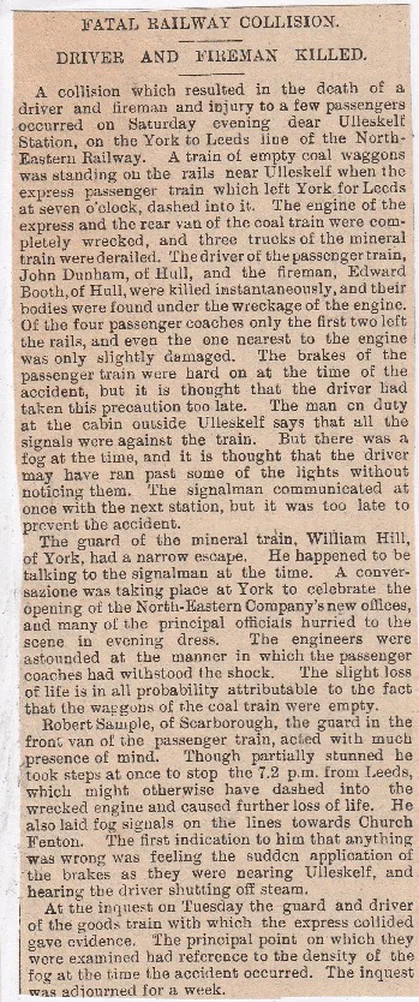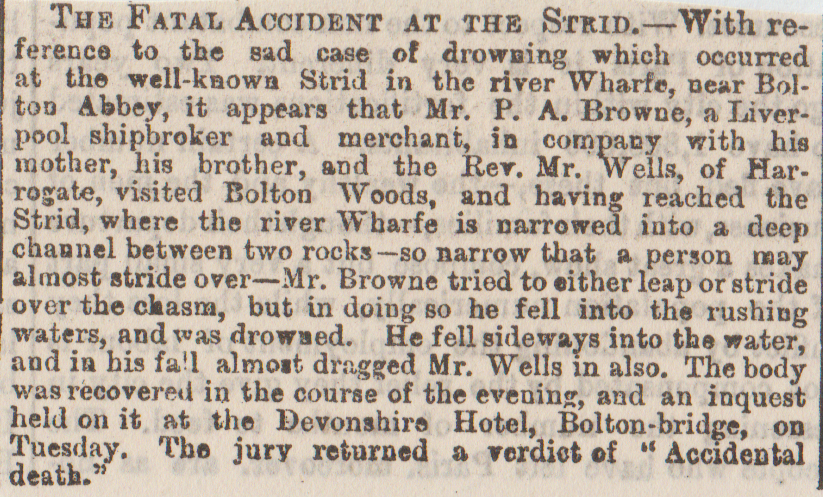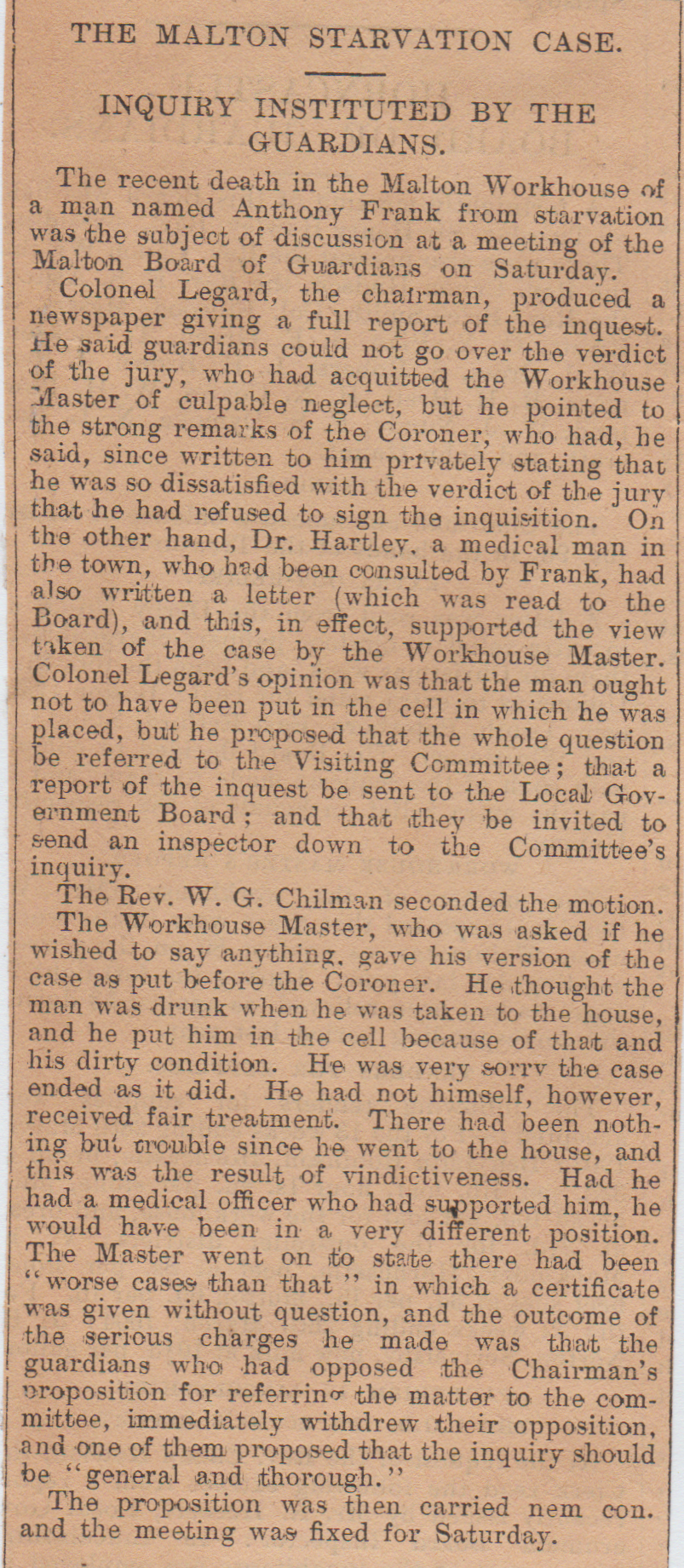1/ Downholme, (Vicar’s Suicide) July 1883
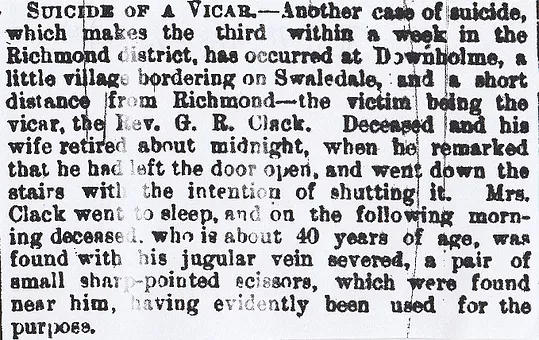
2/ York Minster Fatality, September 1829
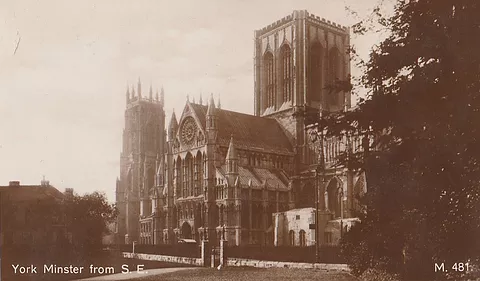
Henry Stranger was on the scaffolding that was used for roof repairs on the Minster. He removed one the twenty-foot planks when he slipped and fell down to the pavement below, causing instant death. It was an eighty-foot drop from the scaffolding to the ground.
3/ St Mary’s Church Fatality, Boston Spa, November 1888
A young man named Thirlwall was suffocated in St.Mary’s Church, Boston Spa, on Saturday afternoon. He had gone into the church and sat down near the heating apparatus and was overpowered by the fumes. (On the High Street, across the road from Crown Hotel)
4/ Scarborough Harbour Drowning, June 1899
On Thursday, a little boy named Bradley, son of Joseph Bradley, from Mosey Hill in Scarborough fell into the harbour and was drowned.
5/ Ripon Child Kidnap, July 1885
At Ripon yesterday Emma Forbes of Sheffield, was committed for trial charged with decoying away the three children, aged ten, eight and six, of Peter Poulton, Ripon, shoemaker. The prisoner had acted as house-keeper from 1st March until last Thursday when she took the children away with her. She was arrested at Knaresborough with them in her charge.
6/ River Ouse Boat Drowning, York, August 1885
James Hazel an excursionist from South Shields, was drowned on Friday in the River Ouse at York. With two companions he hired a pleasure boat and after rowing some distance the men attempted to change seats. The boat was canted over and Hazel, losing his balance, fell into the water and was drowned.
7/ Scarborough Suicide, March 1885
On Saturday, a Scarborough painter named Robert Thompson committed suicide by hanging himself by a cord affixed to a hook in his bedroom door jamb. The deceased had been out of work for some time and he had become destitute. He had frequently expressed his great abhorrence of the workhouse and it is believed that the fear of entering the workhouse caused the unfortunate man to take his own life.
8/ Filey Landslide Fatality, August 1903
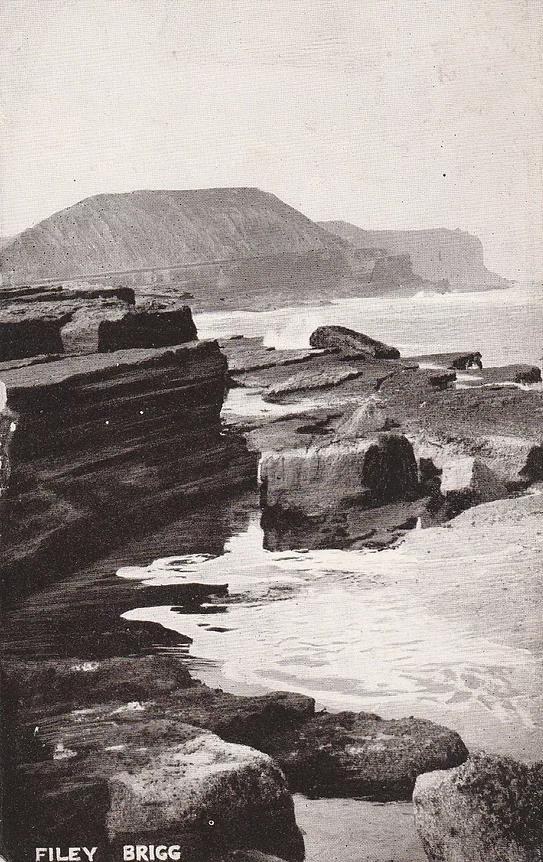
An awful accident occurred at Filey resulting in a fatality. Mrs Dixon, the wife of a civil engineer of Harrogate, was with her kids and the nurse she employed on Filey Sands, along with Mrs Burnett of Harrogate and her children. They had been paddling in the sea and went back to get dried at the foot of the cliffs. The cliff slipped and fell onto Mrs Dixon and her six-year-old boy, John, and the nurse. When they were dug out the boy was terribly crushed, with the face was unrecognisable and the mother unconscious but breathing and the nurse escaped any injury.
9/ Bolton Abbey Fatal Accident, July 1858
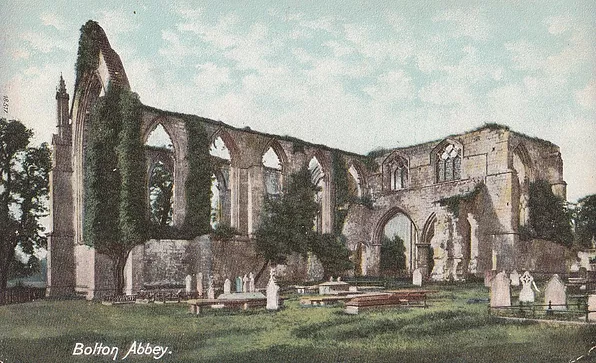
Mr E.J.Greene of Barnsley, met with a fatal accident at Bolton Abbey, while there with a group of day-trippers on a picnic party. Mr Greene left Leeds in the morning with around thirty others and headed for Bolton. They arrived at Skipton and were met by two omnibuses, which took them to the Devonshire Arms, Bolton Bridge where they had lunch, then headed off for the Abbey.(Above) There is a road which skirts the Strid and two omnibuses were trying to pass each other in opposite directions, so some of the passengers got out to stretch their legs. Mr Greene was on the top deck and he got up when the bough of a tree smacked him on the head and knocked him off, landing head-first. He was taken to the Devonshire Arms and after several hours of recuperation and medical assistance, he came to and began to apologise for holding things up. Everyone thought he looked and behaved normally, therefore he was only stunned by the fall and well enough to travel home. On the journey to Leeds, he suddenly worsened and he became delirious. The next morning he died from concussion of the brain.
10/ Staithes Cliff Suicide, August 1892
At Staithes, North Yorkshire, the dead body of Mrs Mildred aged twenty-two-years, who was the wife of a miner, was discovered at the base of a cliff. The cliff was some three hundred feet high, and it is suspected that Mrs Mildred committed suicide by jumping off it.
11/ Middleton Colliery Shaft Suicide, March 1841
A man in Middleton, North Yorkshire, killed himself by leaping down an old colliery shaft. He was depressed and had been ill for a while and his wife spotted him running past the window, then heard him fall. A tub was suspended half-way down the pit and this nearly sliced the fella in two. His name has not been released but he leaves a widow and three children.
12/ Scarborough Castle Cliff Fall, August 1883
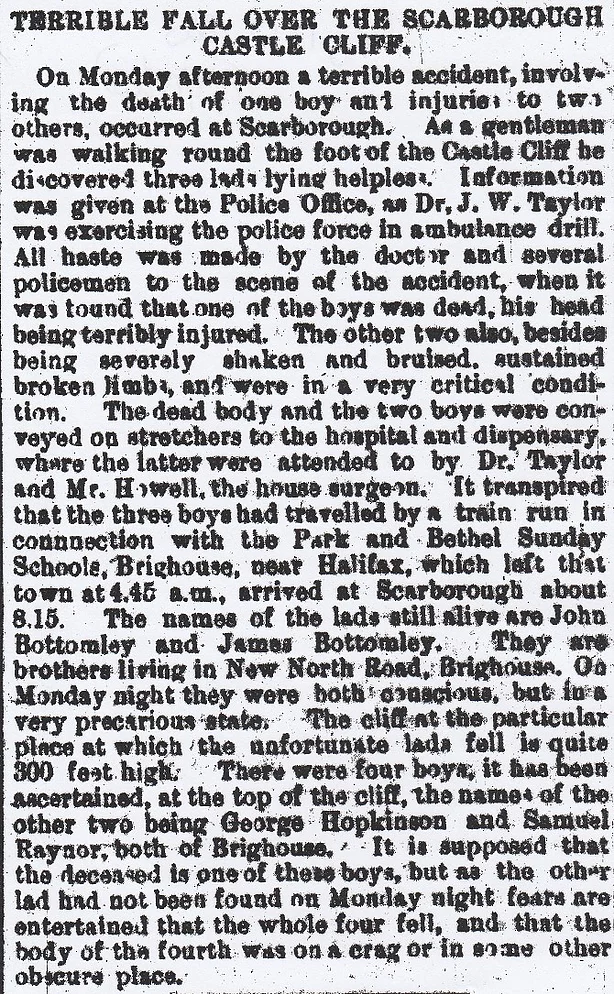
13/ Harrogate Suicide Poisoning, August 1872
An inquest was held at the Alexandra Hotel, Harrogate, regarding the death of 24-year-old Sophia Marshall. She had been staying in Harrogate and was suffering from depression. On Sunday morning she got up bright and early, went downstairs and drank two drachms chloride of zinc from a bottle with a big “poison” label on it. They tried to revive her but she died later on that night. The verdict went accordingly- Died from self-administered poisoning, whilst labouring under temporary insanity.
14/ River Ouse Drownings, York June 1878
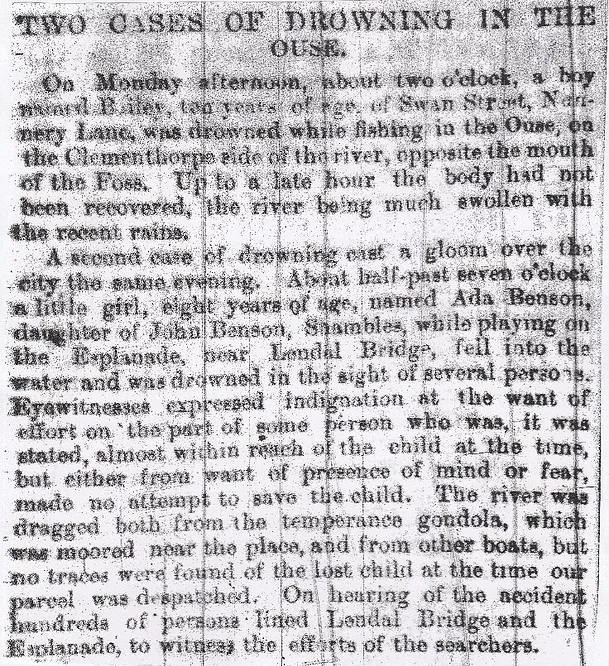
15/ Monk Bridge Suicide, Heworth, April 1860
Mary Lowther of Lyham near Howden, killed herself at Mrs Wray’s house in Heworth where she had been on a visit. Lowther entered into a relationship which her friends did not like in the slightest, and because of this, she had become depressed. On Sunday night she went to bed and then by two a.m.the next morning, she had completely vanished. Her clothes were gone, so she had got dressed and left the house. A search party found her bonnet and skirt on the banks of the River Foss near Monk Bridge and some men dragged the river. After several hours, her body surfaced and it was taken to a nearby inn to await the coroner’s inquest.
16/ Upgang near Whitby Drowning, June 1899
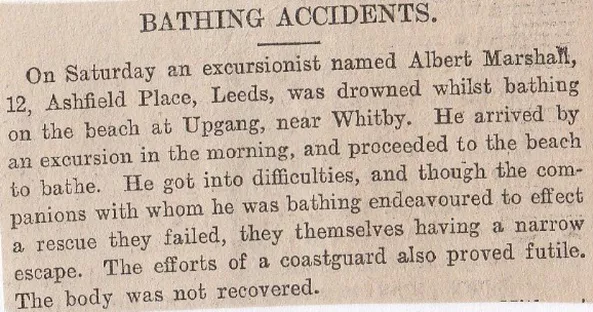
17/ Whitby, (Decomposing Body Found) September 1881
A group of women had gone into a plantation near Whitby to gather in some twigs and sticks for kindling in the winter months, when they stumbled across the decomposed body of a man. The flesh was almost gone from his face, but the clothes were remarkably intact and it is hoped that he can be identified from these. The deputy coroner for Guisborough opened an inquest on Thursday afternoon, but no further evidence had been acquired as to his identity so it was adjourned till Monday. It is believed he was murdered and that some kind of foul play was used. The more likely theory is that it is of John Porritt, a farmer from a place called Buckrush near Whitby. He was last seen alive in July 1880 in a pub at Lythe and from this time on, no-one had seen the bloke again and locals thought he had left the country. (Was it Porritt?)
18/ Yorkshire Coast, (Death from Sea-Sickness) September 1885
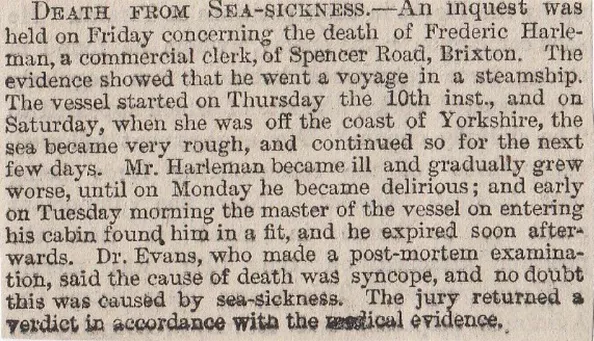
19/ Richmond, August 1917 (Missing Major)
Four miles south of Richmond in North Yorkshire, the body of Major Richardson was discovered on a grouse moor. He was a member of the Highland Light Infantry and was a Glaswegian by birth, where he was a solicitor for quite a while. He was stationed at Richmond and vanished about a week ago. The local heaths and moors were searched but with no success, but a group of soldiers out looking in the bracken, found a corpse. The top part of the head was blown away and a revolver was in the right hand of the body.
20/ Easingwold, December 1837 (Between York and Thirsk)
Eighteen-year-old Mary Peacock was a barmaid at the New Inn, Easingwold. (It is off Long Street and New Inn Lane and is still there) Mary had an argument with her boyfriend a couple of days before and it preyed on her mind so much, she decided to kill herself by hanging from a hook in the wash-house ceiling. She was found almost immediately but she was still dead.
21/ Scarborough Railway Bridge, York, (Two Lads Drowned) February 1885

22/ Middlesbrough, (Circular Saw Death) October 1847
A shocking accident happened to a young lad at Messrs Bolckow & Vaughan’s Ironworks in Middlesbrough. He was lifting one end of an iron bar, which was to be sawn across by a circular saw when his tongs slipped and he fell into the saw. It sliced into his jaw-bone and a huge gash was made on his chest, about a foot long, slicing through all his ribs. There is no hope of him recovering from these dreadful injuries.
23/ Angel Hotel Suicide, Whitby, February 1873
The body of commercial traveller William Savill was discovered in his room at the Angel Hotel in Whitby. He had shot himself in the temple. He worked for Messrs Bourne and Co, who made bonnets, he was only twenty-eight-years-old but had been ill for some time, which could well be the reason for his self-destruction. (The Angel Hotel is still there- it is on New Quay Road near the bridge over the River Esk).
24/ Newton House, Bedale, (Murder/Suicide) May 1841
At the property of the Duke of Cleveland, Newton House, Leeming Lane in Bedale, a murder and suicide took place. The gardener to the Duke, Thomas Robinson, called his 18-year-old son into the greenhouse, then smacked him over the head with a blunt instrument, then stabbed him in the throat and finally, to finish him off, strangled him with a piece of cord. Coolly and calmly Robinson went home and told the missus what he had done and then proceeded to clatter her over the head with the fire-side poker. A relative heard and tried to help, but Robinson put a revolver to his head and pulled the trigger. Robinson had a history of violence, when two years ago he tried to kill a workmate, with the reason for this outburst was that he thought he was in “embarrassing circumstances”. (Is Newton House still there?)
25/ Quarry Moor near Ripon, (Two Drowned) December 25th, 1880
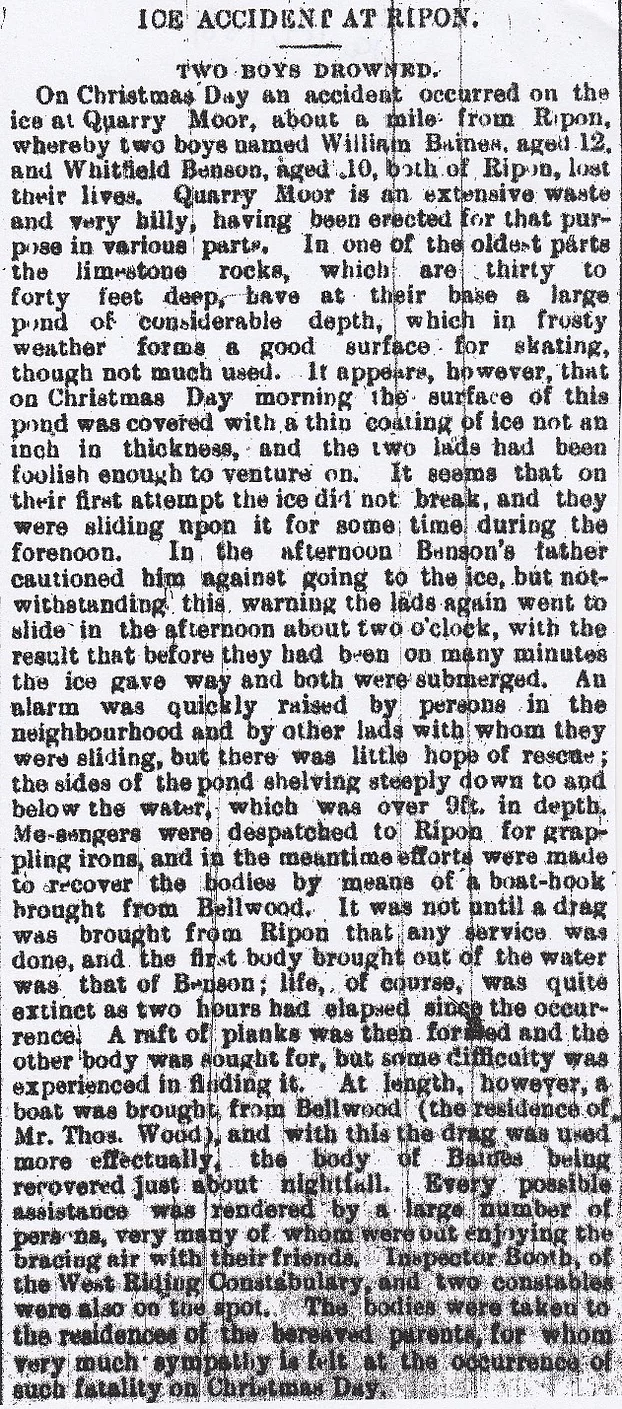
26/ Poppleton Gatehouse, York, (Train Driver Runs over Sister) August 1868
This is a sad story. Mary Ann and Charlotte Burley were up in court, in front of the magistrates, charged with having stolen a purse from a bloke who Charlotte had spent the night. Mary Ann was set free, but obviously, Charlotte was kept behind. Mary Ann was riddled with disgrace and told friends and family that she just couldn’t carry on and said she would do herself in. Here’s where the sad bit comes into the story. Her brother was an engine-driver and the train line passed near to their house, Poppleton Gatehouse, and I think it is still there (On Millgates). It was one evening when the brother was driving the engine that he spotted Mary Ann on the side of the rails. He slammed on the brakes and blew the whistle, but she seemed to fling herself in front of the train and despite his best efforts to stop, the engine ran over her body causing instant death.
27/ Poppleton Bridge Railway Suicide, York, October 1867
The 10-10 from Newcastle was trundling into York, when about a hundred yards from Poppleton Bridge, which crosses the Ouse, a man ran through a gap in the hedge and leaped in front of the train. In a similar story to the above one, which occurred a few hundred yards away, the driver slammed on the brakes but alas he was too late. The body of the man was dragged and churned under the train and carriages for about three hundred yards and finally, it came to a standstill. The remnants of the body were picked from under the engine and the limbs and other portions were taken for a post-mortem examination. The deceased, it turns out, was an escaped lunatic from the North Riding Asylum by the name of Mainprize.
28/ York Castle prison cell, (Attempted Murder/Suicide) September 1885
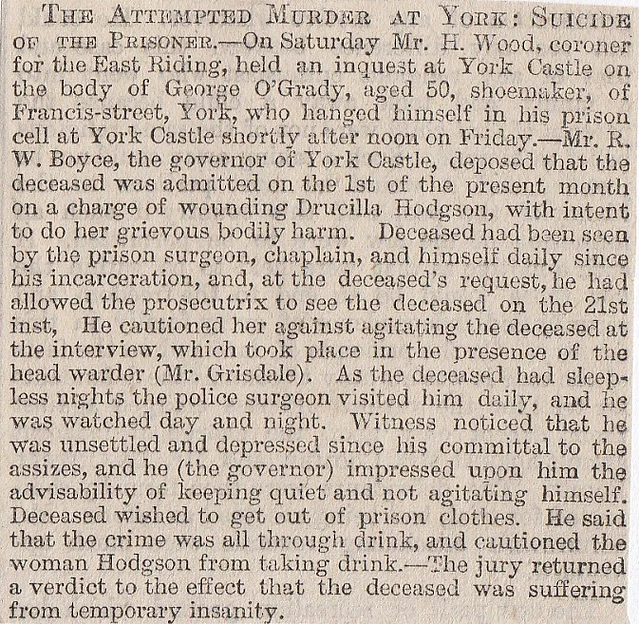
29/ Boltby, March 1863 (Dead Body Dream Comes True)
John Brough from Boltby in North Yorkshire vanished about a month ago, and since then nobody has seen or heard anything of him. Then one evening a neighbour of his had a dream that Brough’s body was in a quarry a few miles away. He told several people about the dream, but they just waved it off as ….a dream. The fellow was adamant that something rang true about the dream, so he set off with his faithful hound to the quarry he had seen. Sure enough, when he arrived there, he found the decomposed remains of Brough with his throat slashed from ear to ear. It was a case of suicide, as Brough had taken off his jacket, rolled up his sleeves and cut his throat with a sharp knife. He was believed to be insane.
30/ York Asylum Suicide, April 1864
Sixty-one-year-old John Tasker was a patient at York Asylum and used to be employed as a magistrates clerk at Liverpool. He was deemed to be a danger to himself, so was put on suicide watch. The attendant who was supposed to be looking after him, a guy named Love, left him alone for a while with a group of other inmates. One of them, Cockshott, had a razor in his hand and was shaving at the time. He’d borrowed it off another attendant called Askwith and while he was soaping himself up, Tasker grabbed the razor and slit his windpipe. He gurgled and gasped for a couple of minutes, but then passed away. Apart from the death of a patient, the attendant Love, lost his job due to his lax attitude while performing his duties.
31/ Beningbrough Train Death, August 1927
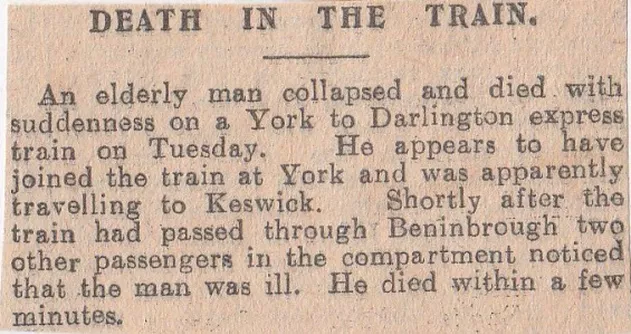
32/ Malton, March 1861 (Lovers Suicide)
A man walking by the bank of the Derwent River, between Old and New Malton, saw some women’s clothing and a bonnet in a bush, along with a Bible with the names of Gill and Preston inside. There was a set of women’s footprints that ended at the edge of the river, suggesting that a young lady had jumped from the bank. This was definitely a suicide. Elizabeth Gill was a domestic servant from Pickering who had started to form a relationship with a lad named Preston, who was from Old Malton. Preston worked at the house where Gill was a servant and he had left on Saturday and he had been followed by Gill. Somewhere along the line they suddenly erupted into an argument together and they both stormed off in opposite directions. She tried to get a room for the night in Old Malton, but failed. She was seen the next morning on the bank of the river reading her Bible. Dragging operations were carried out to find her body and it wasn’t until that evening that she was discovered. She had passed the hair on her head, through her teeth, so she would cover her face before taking the fatal plunge.
33/ River Ouse, York, (Recruits Drowned) October 1869
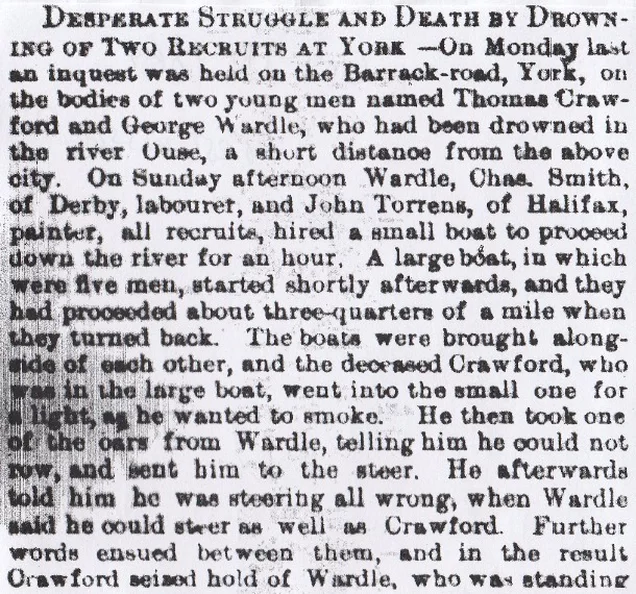
up, then the boat capsized and the two other men, Smith and Torrens, were thrown into the water. Torrens could swim but Smith had to be rescued by the other men. Crawford and Wardle grappled with each other in the river and Torrens tried to part them, but eventually, they drowned. The river was dragged and within an hour both corpses were brought to the surface. The jury’s verdict was that Crawford “Accidentally drowned” and that Wardle’s death was an act of “Manslaughter” by Crawford.
34/ Middlesbrough Murder, May 1908
An inquest was held on the body of Laura Hugh who was found murdered at her home on Saturday night. The mother of Laura identified the body as that of her thirty-year-old daughter who had been married for ten years or so, to Frederick Hugh, who had left her a couple of years ago. The mother didn’t know if she was seeing another man or not but had seen her with a bloke named Harry Holmes. When the mother was questioned as to why the husband and wife had parted, she replied “because of her going out I expect, and coming in late”- apparently, she liked to have a good time and a wee dram at the same time.
35/ Scarborough Boat Fatalities, (Four Dead) August 1868
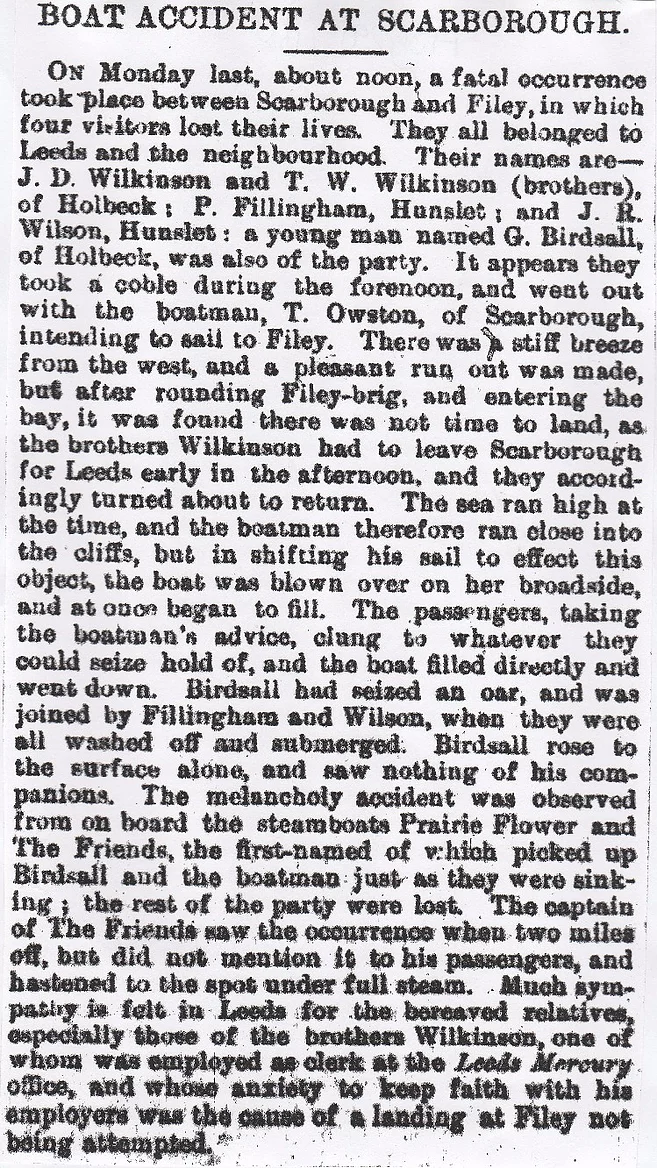
36/ York Double Murder, December 1904
Police are investigating the double murder of an elderly couple named Hewitt, who were found murdered in their house in York. They hadn’t been seen for a while so two blacksmiths apprentices were employed to force open the front door of their house. Mr Hewitt was lying on the kitchen floor with his brains smashed in and Mrs Hewitt was laid on the sofa with a piece of cloth covering her face and head. When removed, it was found that she too had been savagely beaten about the head and her skull had been caved in with a blunt object. The murder weapon has not been discovered but police have a very good idea of who perpetrated the murder. (Who murdered them?)
37/ York Wife Murder, February 1851
John Cooper was arrested and charged with the murder of his wife, Jane Cooper, at the beginning of January 1851. Cooper denies all knowledge his wife’s death by poison, but now the body of Jane Cooper will be exhumed so that an analysis can be made of her stomach contents. The motive for the murder was that Cooper was seeing the daughter of a Wesleyan minister from Alford in Lincolnshire, who he wanted to eventually marry and have kids with.
38/ Lendal Bridge Fatality, York, June 1895 (Not Landel/Its Lendal)
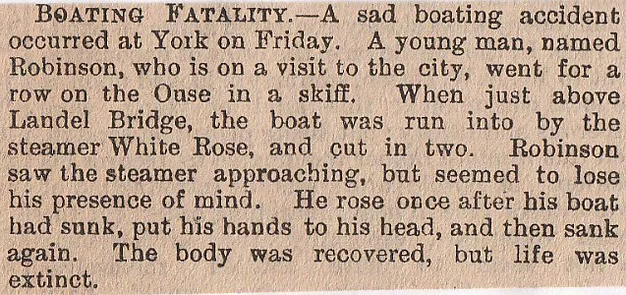
39/ Easingwold, April 1869 (Double Suicide)
If you look a bit further up the list you’ll see one from Malton and that involves another young lass named Elizabeth Gill who killed herself. Just a coincidence, just thought I’d mention it. This one though killed herself with a friend of hers and she was barely classed as an adult, in effect she was just a kid. Elizabeth Gill and Mary Ann Cariss both worked for Mr Haworth, a brewer from Easingwold, Gill being thirteen-years-old and Cariss fourteen-years-of-age. They went to church one Sunday evening with a young lad from Raskelf, named Richard Brough who was seeing Gill at the time. After going missing for a while, the two girls’ hats were found on some railings next to the reservoir, so it was dragged and the two girls bodies were brought in. They had not been molested or beaten up in any way, this was due to lack of bruising or cuts. In the top of their dresses, near the breast, each girl had a prayer book hidden away and evidence suggests that they had threatened to drown themselves on more than one occasion. A witness had seen them testing the depth of another pond nearby with a large stick as though doing a dummy run, but finding this pond not deep enough. Cariss had told someone else that Gill was pregnant and that this could have been the motive for such a rash act. The verdict was one of “Felo de se”.
40/ Scarborough, (Accidental Death) September 1869

verdict of “Accidental death.”
41/ Heslington Family Murder, near York, November 1905
An insurance agent knocked on the back door of the Pinkney’s house at Heslington near York but he received no answer, so he opened the window of the front room and saw Mrs Pinkney lying dead on the floor. He ran to get a policeman and when they entered the home, a truly horrific sight met their gaze. Mrs Pinkney had a child grasped in her arms and next to her was another of the kids, lying in a pool of blood. Mr Pinkney was found with his throat cut and a razor in his hand. Upstairs there was more carnage when they found another small boy lying on a bed with massive head trauma and on the floor of that room lay another girl with her head smashed in. Nearby was a hatchet covered in blood stains and with blood spatter everywhere. That left three children dead, the little one in the mother’s arms was clinging to life was rushed to York County Hospital. The mother died a couple of minutes after being discovered.
42/ Ganton, (Gamekeeper Killed by Poachers) November 1904

43/ Scarborough Suicide, February 1888
William Childerhouse from Hull killed himself in Scarborough under the strangest circumstances. He used to be in well-to-do circles, but lost his position and his money, and ended up on the scrapheap and had to get a position in a household. He tried to rekindle his old fortune by pinching off his employer, who let him off a handful of times but this time there was a warrant out for his arrest. He was found by a detective and when confronted, he locked the door of the room he was in. The door was bust open and Childerhouse dropped into the detective’s arms. He had taken some prussic acid and was already dead.
44/ Malton Teenager Murder, September 1903
A sixteen-year-old domestic servant at Derwent Farm at Scampston near Malton, by the name of Annie Marshall, went to go to the chapel but never arrived. A search of the area found her lifeless body in the River Derwent and in the temple were a couple of bullet wounds. Her mouth had been stuffed with grass to prevent noise or screaming and there were signs that she had been molested and raped. Marshall had been dragged to the river then dumped in the water and already the police have a suspect in detention. (Who was it?)
45/ Rufforth Double Suicide, May 1920
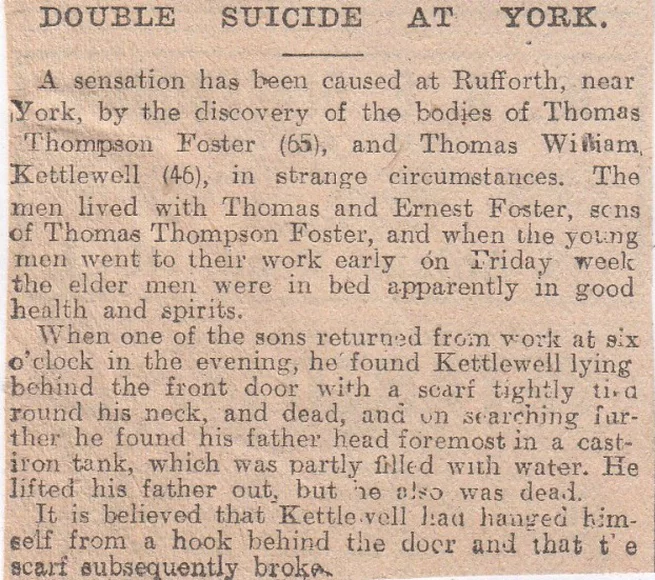
46/ West Sands Suicide, Whitby, June 1871
A young woman named Cooper, who earned a living by keeping a private school, found the pressure of Government inspectors too much to bear and wound herself up to such an extent she committed suicide. A government inspector popped his head in the door of her school in Whitby, purely in a friendly capacity, but Cooper became agitated and told him she worked with kids that long, she had forgotten how to speak to adults. This lingered throughout the day but in the evening she’d calmed somewhat, but sat down and made her will out, wrote a letter to her sister, then stripped off and walked out to sea.The letter read :
“I have enclosed my will in this envelope. I had no idea that I had so many worldly goods to dispose of, but am glad to be able to compensate you all for any trouble you may be put to on my account. Do not fret for me, as I shall be at rest when you read these lines. I could not endure another such a day as today has been. Will you or Barnett be so kind as to lock the doors and take charge of the keys until it is convenient for you to look over closets and drawers. I should not like strangers to turn all upside-down. Give my love to all. Goodbye- Eleanor Cooper, Friday evening, nine o’clock. I am going on the West Sands.”
47/ Beadlam near Helmsley, (Skeletal Remains) November 1881
Some workmen were removing the flagstones from a farmhouse floor, so they could put in floorboards instead when along the wall they discovered some quicklime. Digging in the lime they eventually found a pair of shoes sticking upwards and inside was a pair of man’s feet and some other random bones as well. It all seemed very neat and fresh and the pick-axe used to bury the body was also in the hole. Dr Bell from Helmsley examined the bones and skeletal remains and concluded that it was the body of a very tall man, and the house being more than a century old he thought it could be from that time era. The buttons on the coat were halfpenny sized flat-topped steel kind, used in the late 1700’s or early 1800’s. (Was he ever identified?)
48/ Helmsley Double Murder, June 1895
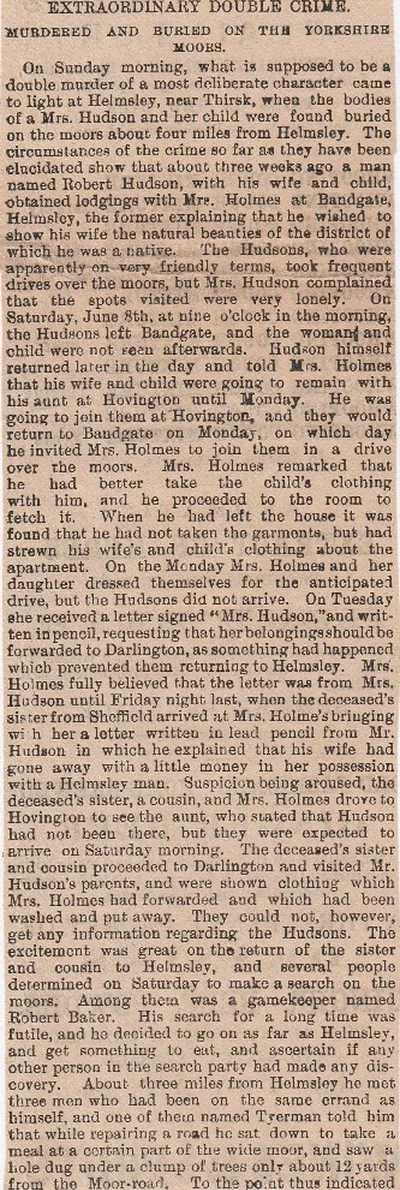

Helmsley Murders, June 22nd, 1895
The alleged Helmsley murderer was removed from Malton to Helmsley today, he was brought before the Earl of Faversham and formal evidence was given. The prisoner was remanded to York Castle for eight days. Exciting scenes were witnessed in Helmsley and along the route. The accused appeared very dejected.
49/ Helmsley Murders, July 27th, 1895
The trial of Robert Hasseltin Hudson on the charge of the murder of his wife and child on Roper Moor on the June 8th took place at York Assizes. Mr Waddy, the prosecutor, said the jury would probably come to the conclusion that a carefully studied plan had been executed by Hudson.He detailed the circumstances of the crime and concluded by calling three lunacy doctors, who having examined the accused, now deposed that he was of sound mind, and knew perfectly well the nature of the act he had committed.Mr Wragge, defending, deposed that they failed to notice any signs of epilepsy in the prisoner.The prisoner’s father said his son was always delicate.Mr Wragge said the jury had listened to one of the saddest and most melancholy tragedies in Yorkshire history.He suggested that the actions of the prisoner on and preceding the day of the murder, were inconsistent with sanity.The prisoner was suffering from the earlier stages of epilepsy.
The judge said there was nothing to show the accused did not know what he was doing- The prisoner was found guilty and sentenced to death.
50/ Warrenby, Redcar, (Fatal Boiler Explosion) June 1895

51/ Scarborough, (Seven Dead in Fire) June 1898
A report came through that Mrs Brooks and her six children had been burned to death in a shop fire at Scarborough. The shop (Health and Safety would have a heart-attack) contained bamboo goods and fireworks! Not surprisingly the building was a pile of ashes within three hours and the alarm was raised by a man passing along Queen Street, who noticed flames at the shutters. A man was noticed on the roof of a hotel which adjoined it and this was Mr Brooks. He seemed dazed and had jumped twenty feet from the building, severely cutting and bruising himself in the process. He was incoherent when asked about the fire but the truth came out a couple of hours later. When firemen entered after the fire they found Mrs Brooks and her sixteen-month-old baby burned to death, lying on the floor of the second storey bedroom. They were burned to a cinder and she was still clutching the child in her arms and in the back bedroom were the other five children. The eldest, a girl of fourteen, had tried to escape but the heat and smoke overpowered her and the flesh had been burned from her breast. The other four lay in bed, rather peaceful, probably dying of smoke inhalation before they were burned to ashes. Mrs Brooks was thirty-eight-years-old and she had four girls and two boys, all of whom are deceased.
The lamplighter who gave the alarm said he heard no glass being broken or nobody shouting for help. A witness also said of Mr Brooks “I never saw a man take things more quietly in my life”-(Applause in Court)-“When he came down from the roof, if only he had said something, we should have made an attempt at once to save his wife and children”- Did he do it?
52/ Selby Railway Station, (Fatal Accident)August 1892
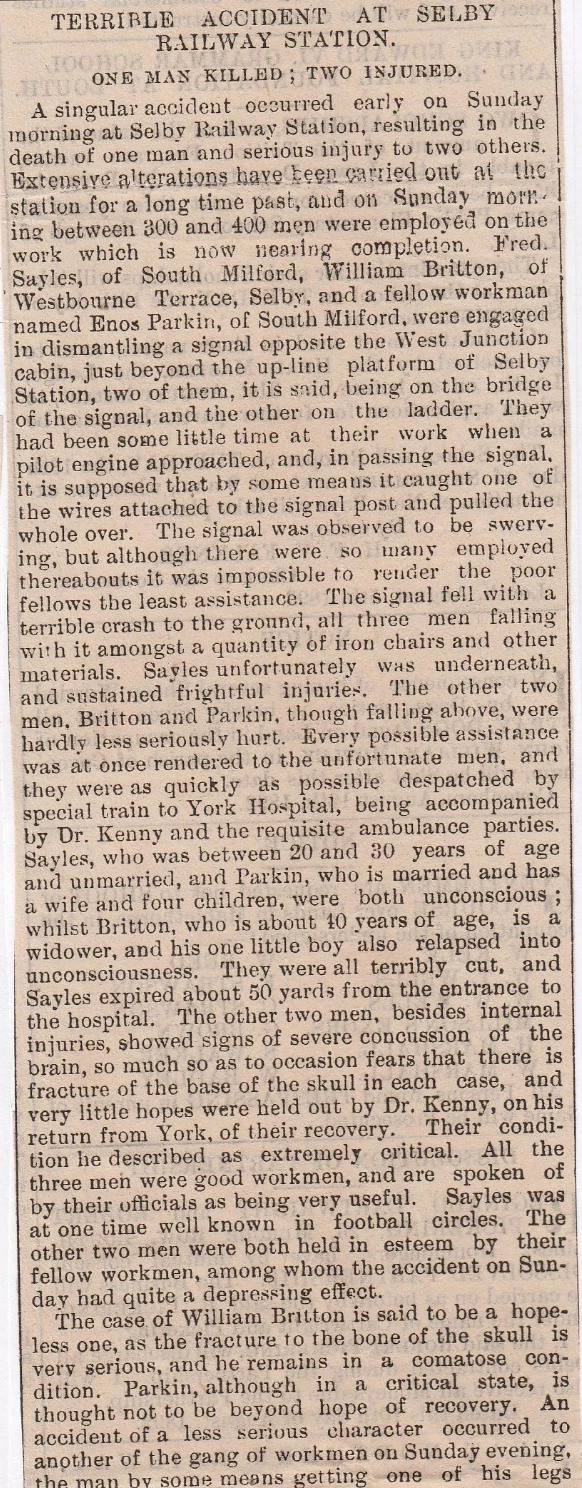
severely crushed.
53/ Middlesbrough Railway Station Suicide, May 1880
A 65-year-old man named Metcalf was being moved by a couple of officer’s from Middlesbrough to York Castle when at the railway station, he pulled out a pen-knife and slit his throat twice, dying an hour from his injuries. The verdict was one of “Felo de se” or suicide, and the coroner issued a warrant to the Chief Constable of Middlesbrough and the churchwardens of the parish to bury the deceased within 24 hours of his suicide between the hours of nine and midnight. He was buried at 10-30 on Saturday night at the New Cemetery in Linthorpe, with no mourners present or any service being read. On the contrary, it was a very slap-dash burial with the body in a very poorly made coffin and the grave had not been dug when they arrived with him on the hearse. It was dropped off, with the rest of the grave hastily dug out, then he was dropped in.
54/ Young’s Commercial Hotel Suicide, Rougier Street, York, August 1892
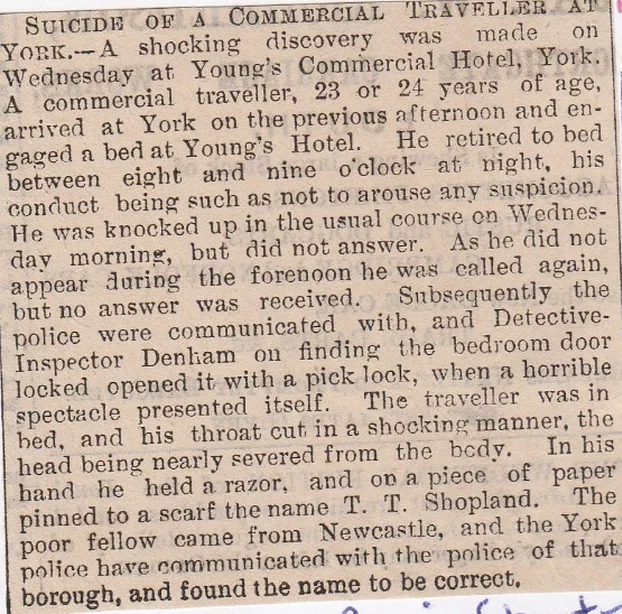
55/ Malton Road, York, (Double Suicide) April 1902
Walter Gurdon was walking his dogs down Malton Road when they started sniffing about a man and a woman who were lying on the ground. When he got there he found they both had their throats cut from ear to ear. The woman was blindfolded. The man was soaking wet, so it is thought that he tried to drown himself first but failed. He is from Huddersfield and was named Carter, but an address in her pocket now suggests that she is the daughter of a Barnsley horticulturist named Bray, but she working in Huddersfield as a barmaid. She had received a telegram from him asking her to meet him in Leeds and the next anyone saw of them was when they found dead. Carter was about fifty years of age and married with three kids, she was only twenty-eight-years old. Her sister got a letter from Carter stating that: “he and Kate would have joined the angels by the time the letter arrived.”
56/ Tadcaster Child Abandonment, July 1889
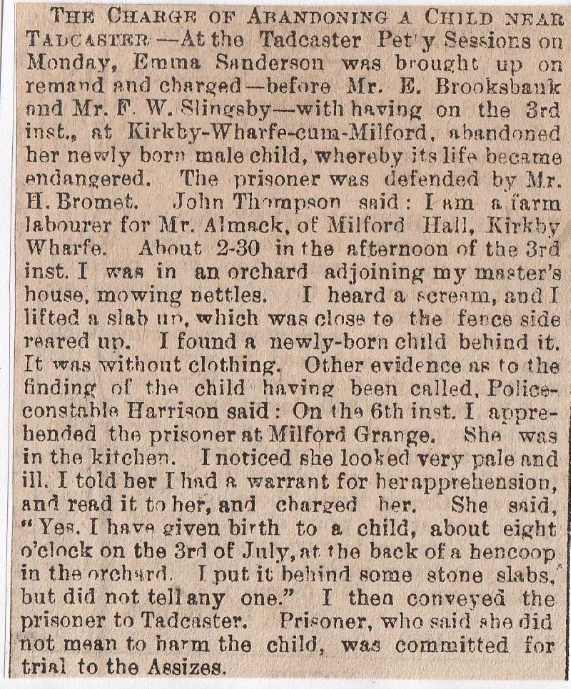
57/ Whitby Vicar Suicide, August 1881
The dead body of the Reverend Francis Augrave, B.A., curate of St John the Baptist’s Church, Peterborough, was found behind a wall of a field beyond the iron shipbuilding premises of Messrs Turnbull and Son, Whitehall, Whitby. The deceased and his brother came to Whitby on a short break and lodged at No 4, Wellington Terrace. He went out the previous afternoon and when his room was checked, they found an account of monies owed plus a list of money owed to him. A note was found addressed to his brother stating his intention to kill himself, mentioning that he had been told by doctors that his consumption was a hopeless case and would be the death of him. In his note, he wrote-“I cannot bear this slow death any longer”. He thanked everyone for their kindness, then put “Goodbye. God Bless you.” Deceased was in his early thirties and ended his life by blowing his brains out with a pistol.
58/ Whitby Beach Drowning, August 1896
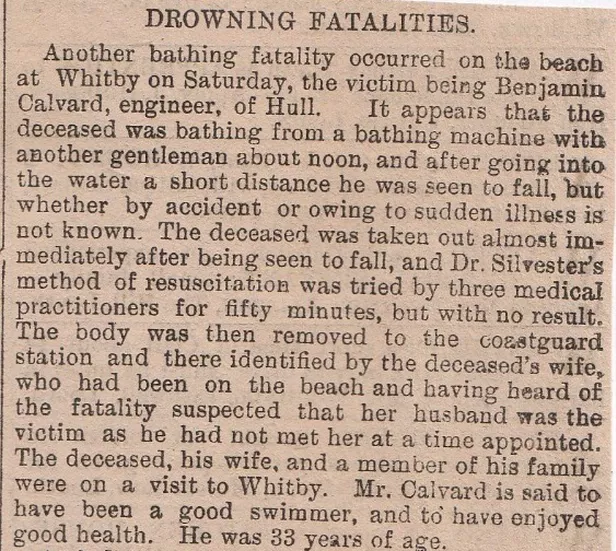
59/ Scarborough, (Accident or Suicide?) November 1898
At the foot of Castle Hill rocks, the mutilated corpse of sixty-seven-year-old Reverend H.H.Wright, late vicar of St Silas Parish in Sheffield, was discovered by some anglers. A marine drive is being built around the base of Castle Hill and the Reverend Wright’s body was about a hundred yards from the construction site. It appears that he had either jumped or fallen the two hundred feet from the top of Castle Hill. The skull was fractured, with both arms broken and one of his legs as well. The Reverend had been suffering from mental debility since giving up his clerical duties and was staying at No.6, Belmont Terrace, Scarborough, with his wife and two sons. The wife said he’d shown great improvement since coming to Scarborough.
60/ Clarence Gardens, Scarborough, (Attempted Murder/Suicide) February 1901
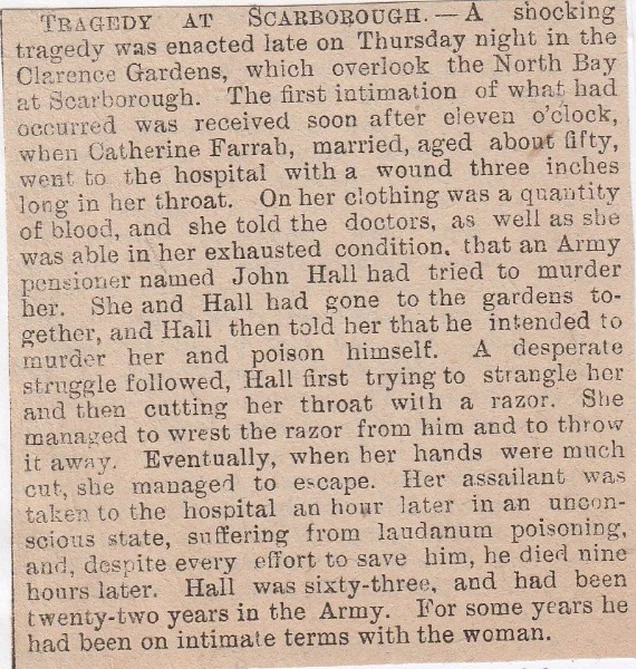
61/ Wheldrake near York, (Boy’s Suicide) September 1880
An inquest was held at Wheldrake on the body of George Edward Allcroft, the fifteen-year-old son of James Allcroft, a gamekeeper of Salt Heath near Stone in Staffordshire. Allcroft was living with his uncle, William Frost, who is the gamekeeper at Wheldrake, and was subject to a fluctuation in his spirits. (Asperger’s or similar?) He had been helping Mr Atkinson harvesting and when it was the men’s dinner break he wafted off on his own, then his cousin, Clara Frost heard the report of a gun at 1-30 p.m. She went to a cabin that he spent his spare time in and found his body on the floor, with a gun underneath his body. There was a piece of twine attached to the trigger which proves that this was a case of premeditated suicide.
62/ Ulleskelf Station, (Driver/Fireman Killed) November 1906
